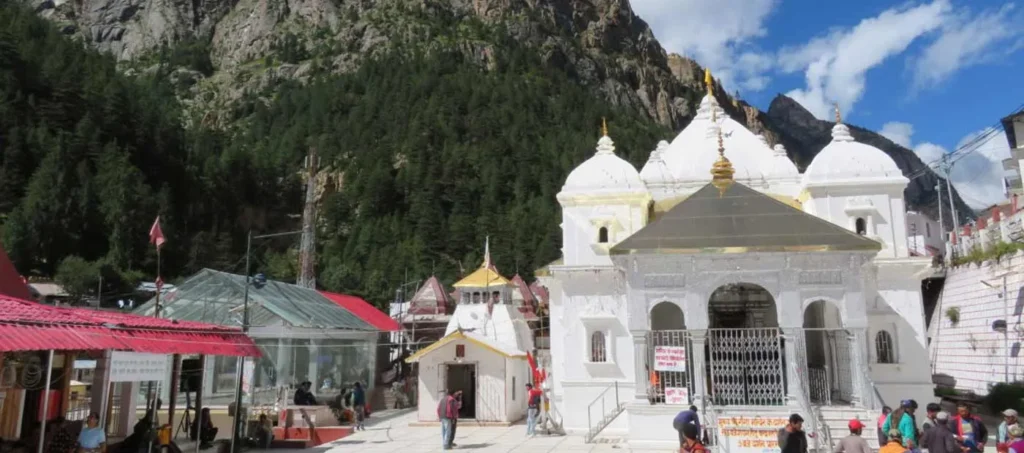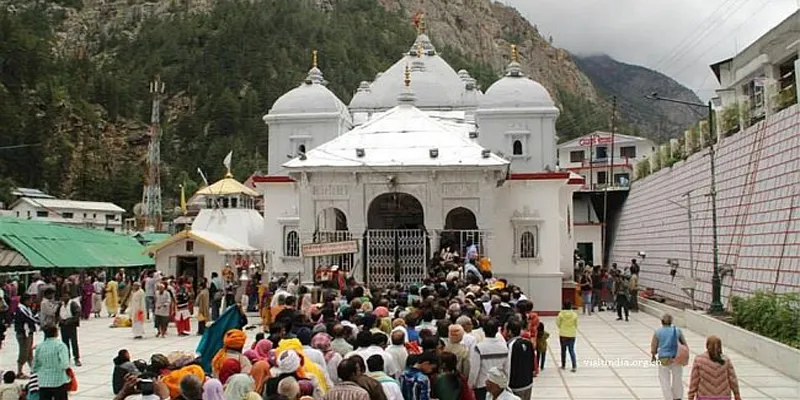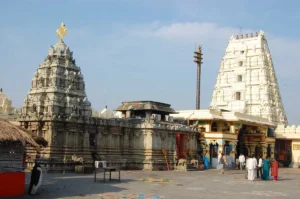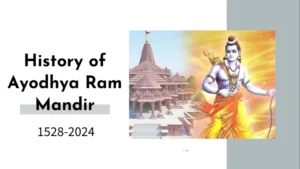Gangotri is a significant spiritual site in Uttarkashi district of Uttarakhand. It is one of the sacred Dham of Chota Char Dham circuit in Uttarakhand. Gangotri Dham offers the splendid views of the Himalayas and River Ganges flowing around. Gangotri is the birthplace of Devi Ganga. River Ganga emerges from Gangotri glacier also called Gaumukh.
Not just famous for religious importance, Gangotri is the perfect destination for tourists to admire the untainted natural beauty and views.
About Gangotri Temple
The pious shrine of Gangotri looms at a height of 3,100 meters. Enclos by deodar and pine trees, the temple is dedicat to Goddess Ganga. Thousands of devotees flock to the temple every year to seek blessings of Goddess Ganga. Gangotri temple was built in the 18th century by the ‘living lion of Nepal’, Gorkha General Amar Singh Thapa.
Structure of the Gangotri Temple
Gangotri temple has a simple formation made of white granite. No carvings or engravings can be found on the temple walls. It is about 20 feet high. The whole shrine is construct in traditional North Indian architectural style. The entrance to the temple is via Sabha Mandap leading to the Garbhagriha which shelter the Goddess Ganga deity.

Inside Gangotri Temple
Garbhagriha or Sanctum sanatorium – It is one of the main section of the temple. Garbhagriha houses Goddess Ganga idol.
Mandap or Assembly Hall – Mandap is located in front of Garbhagriha. It is the area where devotees gather for puja and aarti.
Poojas done at Gangotri Temple
- Mangal Aarti – Mangal aarti takes place early in the morning around 6AM. The doors are closed when the aarti takes place and visitors don’t get to see the aarti.
- Sandhya Aarti – It is a beautiful aarti that takes place in the evening. Sandhya Aarti is performed around 7:45 PM in summers and at 7:00 PM in winters.
- Ganga Devi Pooja – It is one of the main pooja of the temple that takes place on Ganga Saptami Day. In Ganga Devi puja several Ganga mantras and stotram are recited. The pooja take place both at the Ganga Ghat and inside the temple.
Gangotri Temple Opening and Closing Timings
Morning – 6:15 AM to 2:00 PM
Evening – 3:00 PM to 9:30 PM
Afternoon Break – 2:00 PM to 3:00 PM
Festivals Celebrated at Gangotri Temple

Ganga Dussehra – Ganga Dussehra is celebrated very vibrantly in the months of May –June in Gangotri. Pilgrims in huge number participate in the festival. It is celebrated over a span of 10 days. Devotees take a holy dip in the river, chants Ganga stotrams and offer diyas placed on leaf boats that float in the River Ganga. The Ganga Aarti that takes place in the evening light up the divine atmosphere.
Diwali – On the auspicious event of Diwali the idol of Goddess Ganga is taken to Mukhyamanth Temple in the Mukhwa village. The temple works as the abode of Goddess Ganga during winters. Mukhyamanth temple is beautifully decorated with flowers and diyas. Gangotri temple gets closed on Diwali for the winter period.
Akshaya Tritya – On Akshaya Tritya the idol of goddess Ganga is brought back to its home from Mukhyamanth Temple. It is celebrated in the month of April or May when the Gangotri temple gets open. People devotionally decorate the temple and celebrate the welcome back of Goddess Ganga.
Echoes of Antiquity
The legends about Gangotri Dham not only evoke history but also resonate with tales. Gangotri Dham, the rise of which runs as fast as time, is as ancient as its beginnings. In the 18th century, the revered Gorkha commander Amar Singh Thapa raised the temple Gangotri. For long the Gangotri Temple has been touching the hearts of pilgrims or devotees with its divine vibrations.
Myth and Magic: Mythological Foundation
Gangotri Dham is steep in the mythology of Hinduism as it is a sacr location for the followers of the Hindu faith. The river Ganges, as per Indian mythology is said to have been born from heaven and descended on the journey to beat back the sins of mankind since ancient times. Lord Shiva, out of his benevolence, allowed the holy river to find its earthly beginning at Gangotri and make her home in his locks. Consequently, from the tuft of Lord Shiva’s matted hair, Mother Ganges descended on earth to provide spiritual healing and grace to the people.
Legends that Enthrall
It was said that King Bhagirath was the one who performed austerities for the heavenly Ganga to reach Earth. It was a cause to expiate the sins of his progenitors and ancestors. Lord Brahma indeed listened to his prayers and the scared Ganges began to flow. She moves along the footpath created by the hairs of Lord Shiva, which serves as a reminder of the spiritual depths that lie within the very fabric of Gangotri.
Guardian of Life: Environmental Importance
The Gangotri Glacier, a celestial reservoir, nourishes the spiritual thirst of people. It also sustains life in itself, providing livelihood and vital sustenance to millions of people in the Indian subcontinent.
Pilgrims and Prophets: The Pandavas
As narrated in the immortal Mahabharata, the Pandavas went to Gangotri for spiritual upliftment In the Himalayas. In the rough terrain of the Himalayas, they looked for peace and offered sacrifices to the river goddess Ganga. Today, this particular Dham attracts not only local inhabitants but millions of devotees from different parts of the country who come to attain the blessings of the divine Ganges and enjoy the ancient aura of the temple.
Beyond the Mortal Realm: The Rise of Gangotri Dham
Nestled amongst the snow-capped mountains and rich green vegetation, the beauty of Gangotri Dham is a never-ending source of delight and joy. Nature lovers & peace seekers, as well as experienc trekkers, are enchant by the views of Gangotri and the thrills of their adventurous walks through this wonderful place.
Sanctity in Sublimity: Spiritual Awareness and Respect
A cleansing dip in the Holy waters of the river Ganges in Gangotri is a grace for a true Hindu devotee. It is said that a holy dip into the sacre water of the Ganges cleanses all the sins of mankind and in addition. Also feeds the soul with spiritual nourishment.
Guardian of Life: Ecological values
The Ganga Glacier, or the divine reservoir, quenches the spiritual thirst of people. It not only sustains life but is the life itself, which is why the sustenance and livelihood of estimated millions are dependent upon it throughout the Indian subcontinent.

Nature’s Tapestry: Breathtaking Beauty
The haunting peaks and the lush valleys of Gangotri Dham have a special place in every wanderer’s heart aside from its spiritual significance. Each season brought its unique offerings, inviting visitors from across the country to Gangotri Dham, be they devotees or adventurers. In winter portals of Gangotri remain closed because of the extreme climatic conditions and heavy snowfalls. Heavily snowed Gangotri becomes inaccessible for the retreat.
Epilogue: A Journey of the Soul
The rich history and captivating mythology of Gangotri Dham make it a place of immense importance for Hindu devotees and nature lovers. As you embark on your pilgrimage or adventure to Gangotri Dham, remember that it is a journey of self-discovery. Here faith and nature live in harmony, offering solace to the chaotic minds of people.
History and legends about Gangotri
Many mythological stories revolve around the Gongotri Dham which makes it more epic and a significant pilgrimage. Some, of them are:
King Sagara, the great grandfather of King Bhagirath in order to attain supremacy performed Ashwamedha Yagna. During the course of yagna, a horse was allow to let go on an uninterrupt journey across empires. The head ruler Indra on being scar that he might lose his throne if yagna got complet took the horse. He tied the horse in the Sage Kapila ashram where the sage was seat in deep meditation.
Gangotri
The 60,000 sons of King Sagara were give duty of finding the lost horse. They came across the spot where sage was meditating and beside him found the horse tied. The 60,000 sons of the King stormed the ashram and interrupted the deep meditation of the sage. Sage Kapila open his eyes and the 60,000 sons were turn into ashes by his curse. He also cursed that their souls would find moksha only when their ashes will come in contact with holy waters of River Ganga. In order to free his ancestors from the curse and please Ganga to come down to earth, King Sagara performed atonement for a period of 1000 years. Pleased by his devotion, Goddess Ganga descended to earth.
It is said that Ganga, a holy spirit woman was born out of Lord Brahma’s Kamandalu (water vessel). There were two myth attach to her this birth. Brahma washed the feet of Lord Vishnu when he released the universe from the demon Bali in his rebirth as Vaman and collected this water in his Kamandalu.
Legends say that, Ganga came down to earth and married King Shantanu an ancestor of the Pandavas. She yield seven children and all of them were throw into the river by her. The eight child Bheeshma was save by King Shantanu’s intervention. Then Ganga left him. Later, all through the holy epic Mahabharat, Bheeshma played a very significant role.
Also Read: rashid khan ipl salary
Conclusion
Gangotri stands not only as a significant spiritual destination but also as a testament to the rich tapestry of mythology and history woven around it. With its origins steeped in Hindu mythology and its serene beauty nestled amidst the Himalayas, Gangotri offers a profound journey for pilgrims and nature enthusiasts alike. The Gangotri Temple, dedicated to Goddess Ganga, serves as a beacon of devotion and reverence for thousands of devotees who seek solace and blessings. From the legends of King Sagara’s penance to the divine descent of Ganga from Lord Brahma’s Kamandalu, the stories surrounding Gangotri evoke a sense of awe and wonder. As pilgrims embark on their spiritual quests and adventurers explore the breathtaking landscapes, Gangotri remains a timeless sanctuary where faith and nature converge harmoniously, leaving an indelible mark on the soul of every visitor.




